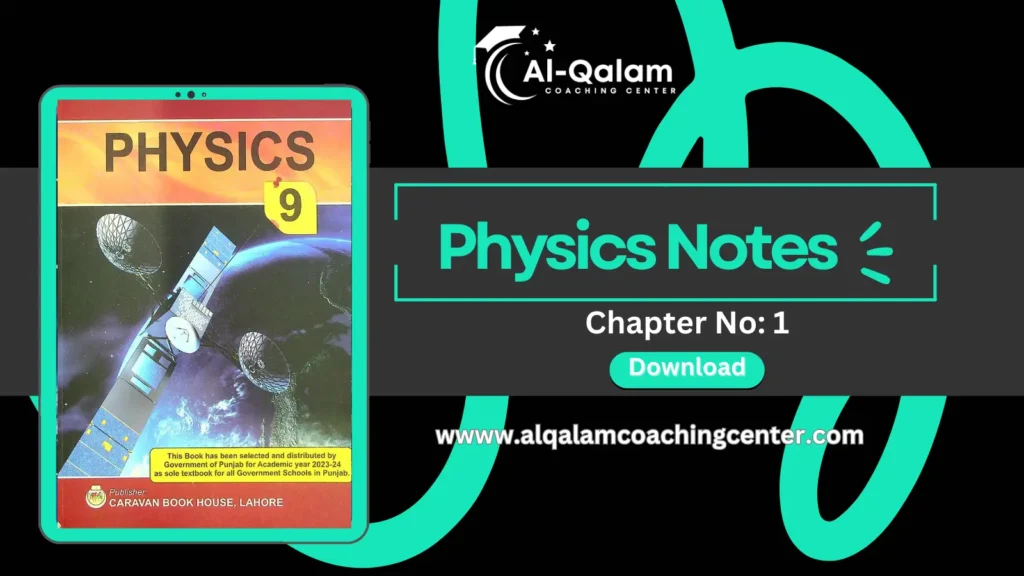Physics Class 9 Chapter 1 Short Questions Notes

Find comprehensive Physics Class 9 Chapter 1 Short questions Notes Physical Quantities and Measurements English medium Physics notes available for online viewing and direct PDF download.
Key Takeaways
- Convenient Access: Easily view or download the complete notes in PDF format.
- Comprehensive Content: Includes theory, solved exercises, MCQs, and numericals.
- Targeted for All: Useful for students from Punjab educational boards.
- Interactive Learning: Features quizzes, real-world examples, and practical applications.
- Accuracy and Clarity: Notes are well-organized and written in simple language for better understanding.
Physics Class 9 Chapter 1 Download PDF Links
- Physics Class 9 Chapter 1 Short Questions Notes ( Urdu Medium)
- Physics Class 9 Chapter 1 Long Questions Notes ( English Medium)
- Physics Class 9 Chapter 1 Numerical Notes
- Physics Class 9 Chapter 1 Test
- Direct Download Via Google Drive
Online Preview Physics Class 9 Chapter 1 Short Questions
Physics Class 9 Chapter 1 Short Questions
Q 1.2 What is the difference between base quantities and derived quantities? Give three examples in each case.
Ans: i. Base Quantities: Seven physical quantities form the foundation of other physical quantities. These physical quantities are called base quantities. For Exp: length, mass, time, electric current, temperature, intensity of light and the amount of substance.
ii. Derived Quantities: Those physical quantities which are expressed in terms of base quantities are called the derived quantities. For Exp: area, volume, speed, force, work, energy, power, electric charge, electric potential, etc.
Q 1.3 Pick out the base units in the following: joule, newton, kilogram, hertz, mole, ampere, meter, kelvin, coulomb and watt.
Ans: Base Units: Kilogram, Mole, Ampere, Meter, Kelvin.
Derived Unites: Joule, Newton, Hertz, Coulomb, Watt.
Q 1.4 Find the base quantities involved in each of the following derived quantities: (a) speed (b) volume (c) force (d) work.
Ans: (a) Speed: It is distance covered per unit time. i.e. v= distance/time. So in speed, base quantities involved are length(distance) and time.
(b) Volume: Volume= length x width x height = length x length x length. So the base quantity involved is length.
(c) Force: We know that F = ma = mv/t = md/t² . In the formula of force the base quantities are mass, length and time.
(d) Work: We know that W = Fd = ma d = mvd/t = md²/t². In formula of work base quantities involved are mass, length and time.
Q 1.5 Estimate you age in seconds.(15 years)
Ans: Suppose the age of student is 15 years.
Age = 15 year
Age in days = 15 x 365 = 5475 days
Age in hours = 5475 x 24 = 131400 hours
Age in minutes = 131400 x 60 = 7884000 minutes
Age in seconds = 7884000 x 60 = 473040000seconds
Age in seconds = 4.7304 x 108 seconds.
Q 1.6 What role SI units have played in the development of science?
Ans: With the development in the field of science and technology the need for commonly acceptable system of units was seriously felt all over the world particularly to exchange scientific and technical information. So, in 1960 International Bureau of Weight and Measures were decided to introduce worldwide system of measurements that is called international system of unit and is commonly written as SI.
Q 1.7 What is meant by vernier constant?
Ans: The least count of vernier calipers is also called vernier constant. It is defined as “the difference between one main scale division and one vernier scale division is called vernier constant or least count.” i.e. 1mm – 0.9mm = 0.1mm.
Q 1.8 What do you understand by the zero error of a measuring instrument?
Ans: In measuring instruments there may be systematic error, due to which a measurement may be less or greater than actual measurement. Zero error influences all the measurements equally. Zero error is caused by incorrect position of zero point.
Q 1.9 Why is the use of zero error necessary in a measuring instrument?
Ans: Sine zero error of instruments affect all the measurements, so it must be necessary that we have to calculate the zero error of an instrument before taking measurements. If we don’t calculate the zero error then consistent difference in the reading will be calculated.
Q 1.10 What is a stopwatch? What is the least count of a mechanical stopwatch you have used in the laboratories?
Ans: A stopwatch is used to measure the time interval of an event. The mechanical stopwatch has a least count of 0.1 seconds.
Q 1.11 Why do we need to measure extremely small intervals of time?
Ans: In nature and also in Physics, there are so many phenomena that vary concerning the extremely small interval of time and for their experimental measurement we need precise time-measuring instruments That’s why e need to measure small iintervalsof time.
Q 1.12 What is meant by significant figures of a measurement?
Ans: All the accurately known digits and the first doubtful digit in a measurement are called significant figures. It reflects the precision of a measured value of physical quantity.
Q 1.13 How is precision related to the significant figures in a measured quantity?
Ans: In any measurement, the greater the number of significant figures, the greater is precision. An improvement in the quality of measurement by using better instruments increases the significant figures in the measured result. The significant figures are all the digits that are known accurately and the one estimated digit. More significant figures mean greater precision. E.g. measurements taken by screw gauge is more precise than vernier callipers and meter rule.
